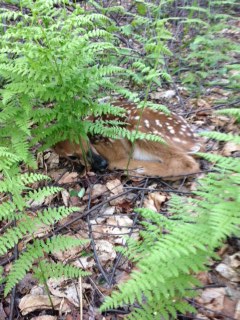In fact, we were having trouble locating does who would even respond to our bleat calls. I had friends finding fawns all over the state of Pennsylvania, and the Northern Fawn Crew had already successfully captured ten or more fawns, but we weren’t having any luck.
What could be wrong? Were our bleat calls faulty? Part of our study area was a state forest with lots of public use, so were the deer used to seeing humans?
Also, much of the habitat we are working in is thick mountain laurel and rhododendron, so are the deer just really good at hiding from us? We had so many questions, and not many answers; however, lately things seem to be looking up.
Today, the deer had us running in circles.
We had three does respond to our bleat calls in the morning. We spent a significant amount of time searching a few wet fields, forest edges, and a woodlot, but had no luck. While we were wrapping up lunch in the state forest, a small brown mammal popped out of the forest and laid down the grass with its back to us—it was a fawn! We noticed it right away, and sprinted after it.
That speedy fawn had all six of us sprinting across the grass at one point. It sneaked back into the forest, where it took shelter under a pine tree and then shot out from underneath the tree past one of our crew. The fawn evaded one of our crew members when it attempted to jump across a culvert, but slipped; however, it quickly picked itself back up.
The fawn then hightailed it onto a trail where it disappeared into some low-to-medium shrubs. What a rush! It was hard to believe that this stealthy little mammal walked right out of the woods, almost as if it were taunting us, but then beat us in a foot race!
After lunch and the first fawn chase (yes—there were more), we began searching a few different areas. Before we wrapped up the day, the crew leader and I went to monitor the fawns that were collared over the last few days. The fawns have to be checked on twice a day. We were almost to one of our collaring sites when I noticed some brown stirring in the grass and the low shrubs on the side of the road.
“Stop,” I yelled, “I think there’s a fawn right here!” Lo and behold, there was a fawn not more than 5 feet from the road! We hopped out of the truck and as soon as he saw me, he ran down through the mountain laurel. To avoid harming him, we ran around the outside of his path to try to cut him off from the front, and he bedded down right in front of us.
We carefully walked through the mountain laurel and gently picked him up before he got away from us again. For a moment, the doe stood right there and watched us, but then she took off through the forest behind us.
We blindfolded the fawn to keep him calm, and then gently slipped the radio collar over his head. We collected his DNA, sexed him, and weighed him. He was nine pounds—the heaviest I’ve handled yet! We then collected some additional information about his health and the habitat where he was captured.
The two of us were able to process him and get him on his way in less than seven minutes. It is important for us to minimize handling time as much as possible to minimize stress.
After we released him, we checked on a fawn that we had collared last Friday. From the intensity and direction of the signal from the transmitter, the fawn was very close!
We believe that the fawn that we had just collared and the fawn that was collared last week in the same area could be brother and sister. Who really knows, but the DNA we collected will help us figure that out. With more luck, two other fawns were captured that today, as well! The Southern Crew caught a total of three fawns in just one day!
What an incredible day! I can only hope for more days like this. One thing is for sure, having nature as your office pays off in more ways than one!
—April Sperfslage, Bio Aide
Southern Fawn Capture Crew
